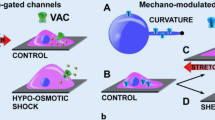Abstract
Stretch-activated non-selective cation currents (I SAC) constitute a mechanism that can induce cardiac arrhythmias. We studied I SAC in mouse ventricular myocytes by stretching part of the cell surface between the patch-pipette and a motor-driven glass stylus. In non-clamped cells, local stretch depolarised and induced after-depolarisations and extrasystoles. In voltage-clamped cells (K+ currents suppressed) I SAC activated by local stretch had a nearly linear voltage dependence and reversed polarity between −12 and 0 mV. Conductance G SAC increased with the extent of local stretch. I SAC was not a Cl− current (insensitivity to replacement of Cl− by aspartate−). I SAC was not a Ca2+-activated current (insensitivity to 5 mM intracellular BAPTA). G SAC was blocked by 5 µM GdCl3 or by 75 mM extracellular (e.c.) CaCl2. Removal of e.c. CaCl2 increased G SAC 2.5-fold, as if G SAC were sensitive to Ca2+ and Gd3+. Replacement of 150 mM e.c. Na+ by 150 mM Cs+, Li+, tetraethylammonium (TEA+) or N-methyl d-glucosamine (NMDG+) yielded currents that suggested for the conductance a selectivity G Cs>G Na>G Li>G TEA>G NMDG. I SAC was suppressed by cytochalasin D, as if an intact F-actin cytoskeleton were necessary for activation of I SAC.











Similar content being viewed by others
References
Anumonwo JMB, Tallini YN, Vetter FJ, Jalife J (2001) Action potential characteristics and arrhythmogenic properties of the cardiac conduction system of the murine heart. Circ Res 89:329–335
Bett GCL, Sachs F (2000) Activation and inactivation of mechanosensitive currents in the chick heart. J Membr Biol 173:237–254
Calabrese B, Tabarean IV, Juranka P, Morris CE (2002) Mechanosensitivity of N-type calcium channel currents. Biophys J 83:2560–2574
Calaghan SC, White E (1999) The role of calcium in the response of cardiac muscle to stretch. Prog Biophys Mol Biol 71:59–90
Cooper JA, (1987) Effects of cytochalasin and phalloidin on actin. J Cell Biol 105:1473–1478
Ehara T, Noma A, Ono K (1988) Calcium-activated non-selective cation channel in ventricular cells isolated from adult guinea-pig hearts. J Physiol (Lond) 403:117–133
Gannier F, White E, Garnier D, Le Guennec JY (1996) A possible mechanism for large stretch-induced increase in Ca2+ i in isolated guinea-pig ventricular myocytes. Cardiovasc Res 32:158–167
Hu H, Sachs F (1996) Mechanically activated currents in chick heart cells. J Membr Biol 154:205–216
Hu H, Sachs F (1997) Stretch-activated ion channels in the heart. J Mol Cell Cardiol 29:1511–1523
Hunter PJ, McCulloch AD, Ter Keurs HEDJ (2002) Modelling the mechanical properties of cardiac muscle. Prog Biophys Mol Biol 69:289–331
Isenberg G, Klöckner U (1982) Calcium currents of isolated bovine ventricular myocytes are fast and of large amplitude. Pflugers Arch 395:30–41
Isenberg G, Klöckner U (1982) Calcium tolerant ventricular myocytes prepared by preincubation in a "KB Medium". Pflugers Arch 395:6–18
Janvier NC, Boyett MR (1996) The role of Na-Ca exchange current in the cardiac action potential. Cardiovasc Res 32:69–84
Kamkin A, Kiseleva I, Isenberg G (2000) Stretch-activated currents in ventricular myocytes: amplitude and arrhythmogenic effects increase with hypertrophy. Cardiovasc Res 48:409–420
Kamkin A, Kiseleva I, Wagner KD, Leiterer KP, Theres H, Scholz H, Gunther J, Lab MJ (2000) Mechano-electric feedback in right atrium after left ventricular infarction in rats. J Mol Cell Cardiol 32:465–477
Kazanski V, Isenberg G (2002) Gradients in cytosolic sodium concentration [Na+]c caused by stretch activated currents (guinea-pig ventricular myocytes) (Abstract). Pflugers Arch 443:S348
Kiseleva I, Kamkin A, Wagner K-D, Theres H, Ladhoff A, Scholz H, Günther J, Lab MJ (2000) Mechano-electric feedback after left ventricular infarction in rats. Cardiovasc Res 45:370–378
Lab MJ, (1996) Mechanoelectric feedback (transduction) in heart: concepts and implications. Cardiovasc Res 32:3-14
Lu J, Liang Y, Wang XL (2002) Amiloride and KB-R7943 in outward Na+/Ca2+ exchange current in guinea pig ventricular myocytes. J Cardiovasc Pharmacol 40:106–111
Nazir SA, Lab MJ (1996) Mechanoelectric feedback and atrial arrhythmias. Cardiovasc Res 32:52–61
Petroff MGV, Kim SH, Pepe S, Dessy C, Marbán E, Balligand JL, Sollott SJ (2001) Endogenous nitric oxide mechanisms mediate the stretch dependence of Ca2+ release in cardiomyocytes. Nat Cell Biol 3:867–873
Puglisi JL, Bers DM (2001) LabHEART: an interactive computer model of rabbit ventricular myocyte ion channels and Ca transport. Am J Physiol 281:C2049–C2060
Sachs F, Morris CE (1998) Mechanosensitive ion channels in nonspecialized cells. Rev Physiol Biochem Pharmacol 132:1-77
Schneider P, Hopp HH, Isenberg G (1991) Ca2+ influx through ATP-gated channels increments Ca2+ i and inactivates I Ca in myocytes from guinea-pig urinary bladder. J Physiol (Lond) 440:479–496
Sigurdson W, Ruknudin A, Sachs F (1992) Calcium imaging of mechanically induced fluxes in tissue- cultured chick heart: role of stretch-activated ion channels. Am J Physiol 262:H1110–H1115
Thijssen VL, Ausma J, Borgers M (2001) Structural remodeling during chronic atrial fibrillation: act of programmed cell survival. Cardiovasc Res 52:14–24
Yang X-C, Sachs F (1989) Block of stretch-activated ion channels in Xenopus oocytes by gadolinium and calcium ions. Science 243:1068–1071
Yang X-C, Sachs F (1990) Characterization of stretch-activated ion channels in Xenopus oocytes. J Physiol (Lond) 431:103–122
Zeng T, Bett GCL, Sachs F (2000) Stretch-activated whole cell currents in adult rat cardiac myocytes. Am J Physiol 278:H548–H557
Acknowledgements
The work was supported by the Deutsche Forschungsgemeinschaft TR-02 project A3 and by the Max-Planck-Award of the AvH.
Author information
Authors and Affiliations
Corresponding author
Rights and permissions
About this article
Cite this article
Kamkin, A., Kiseleva, I. & Isenberg, G. Ion selectivity of stretch-activated cation currents in mouse ventricular myocytes. Pflugers Arch - Eur J Physiol 446, 220–231 (2003). https://doi.org/10.1007/s00424-003-1018-y
Received:
Accepted:
Published:
Issue Date:
DOI: https://doi.org/10.1007/s00424-003-1018-y




